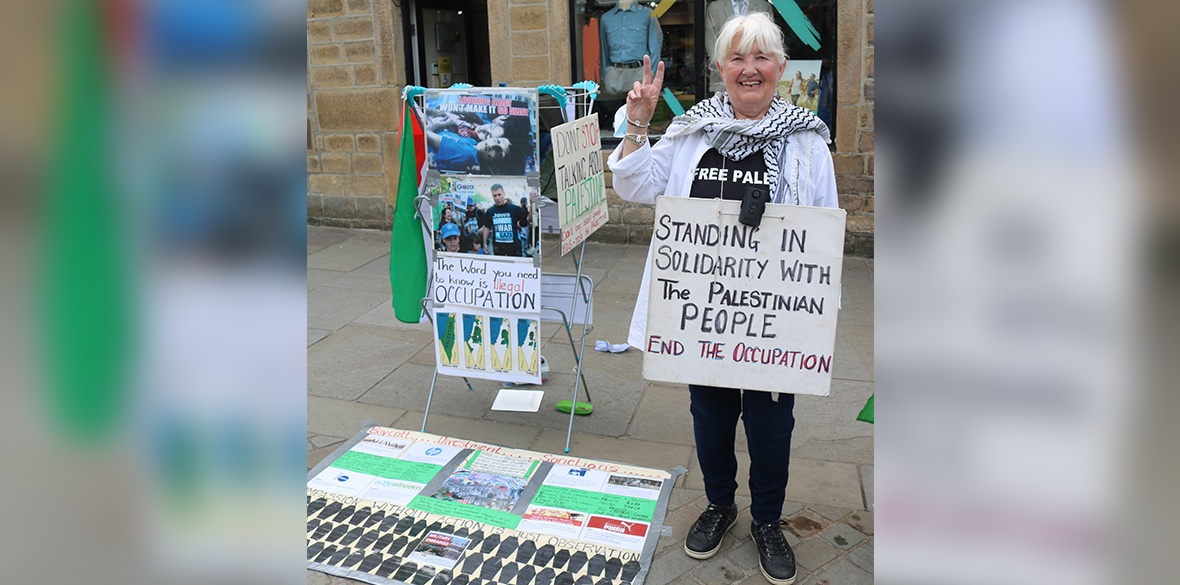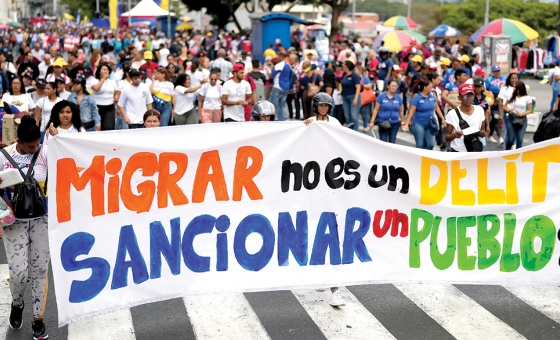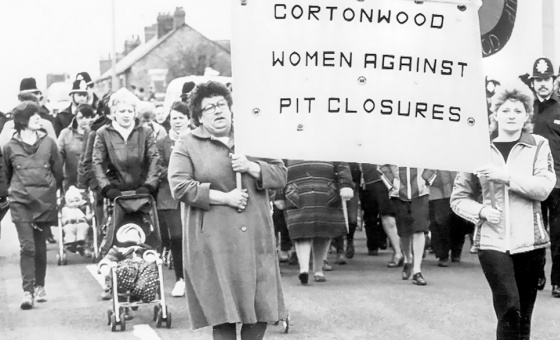This is the last article you can read this month
You can read more article this month
You can read more articles this month
Sorry your limit is up for this month
Reset on:
Please help support the Morning Star by subscribing here
CHRISTINE DRAKE knows a lot about verbal abuse, threats and harassment.
She’s suffered all three during the last seven years as she’s mounted a weekly, one-woman campaign in support of the people of Palestine.
Four days a week Drake stages a solo demonstration in the town square near her home in Hebden Bridge in the Calder Valley in West Yorkshire.
From Thursday to Sunday, using a collapsible clothes rack as a frame, she displays posters, home-made placards, photographs, including some of children killed in Israeli attacks on Palestinians.
The display is next to a lamppost, which she drapes with a Palestinian flag. Another hangs on the clothes rack.
Hebden Bridge is surrounded by Pennine hills and straddles the Rochdale canal and the River Calder.
It’s a popular destination for tourists and other visitors, and Drake has handed out thousands of leaflets about Palestine to people meandering through the square.
Round her neck hangs a placard reading: “Standing in solidarity with the Palestinian people. End the occupation.”
Also hanging round her neck is a small camera. She uses it to photograph anyone who is antagonistic or threatening towards her — and there have been a few.
The camera is a smart move. Drake, a veteran of the Greenham Common Women’s Peace Camp against cruise missiles of 1981 to 2000, is 74 years old and just 4’ 11” tall.
She would have little hope of defending herself in the event of a physical attack.
The camera is intended to be a deterrent against any would-be attacker. It’s worked so far.
She was injured, though, when a council official tried to tear down her clothes rack display because she hadn’t permission to have it there, and she was putting posters on council-owned “street furniture” — an iron litter bin. She suffered a deep scratch to her arm in the struggle.
“There was blood everywhere,” she says. “He tried to take my display down but I held onto it.
“Someone called the police. I told them the man had attacked me, and I made a complaint.
“The police came back three days later and told me the case was closed. They said they were taking no action because ‘I’d brought it on myself’.”
The verbal attacks can be nasty and threatening.
She says: “The other day I was threatened by someone. He was a big man. He told me I was the sort of person who would be shoving bodies into gas ovens.
“And he said: ‘I know where you live,’ and he didn’t mean he would pop round for a cup of tea. I told him that everyone knows where I live. I felt quite angry. But I didn’t feel scared or anything.
“I’ve had zionists here,” she says. “They say: ‘You’re a liar, you’re a terrorist.’ I don’t take any notice of that garbage.
“It’s quiet now,” she tells the Morning Star when she was interviewed during one of her Saturday vigils, “but it’s never really safe.”
She’s been visited many times at her protest site, and at home, by police and officials.
Council officials called a meeting about her activities in the local town hall after there had been complaints about her. She refused to attend.
“I’ve had the hate crime police here twice,” she says. “Police have threatened to arrest me. They were coming every day. They said I should take the display down. I refuse to take it down. They’ve come to my home. They were ringing me up.
“And this is how petty the council can be. When I first started here I used to put posters on a litter bin next to me. The council moved the litter bin.”
She points to a sturdy iron litter bin a few yards away. It must have taken some effort to shift it.
So now she uses the lamppost instead. And her clothes rack. It opens and rises up easily with the pull of a lever.
Her posters and photos are already attached with sticky tape, and after her daily three- or four-hour stint she simply pulls the little lever to collapse it, folds up her Palestine flags, and walks to the home of a friend around the corner, where she stores her equipment. Her own house is a bit further away.
Her latest addition to the display is a home-made poster on the ground in front of the clothes rack, with the images of 65 small, black coffins representing the children killed in Israel’s 11-day attack on Gaza in May.
Round the perimeter of the town square are three cafes, a pub, two pie shops, a butcher’s and two shops selling fashion clothing.
The cafes and the pub have outside tables and seating which are packed with people on sunny days.
Drake’s display stands alongside sandwich boards advertising cream teas, fine ales and the like.
“One of the coffee shops said the photographs on the display were disturbing the customers,” she says.
“I told them that the customers SHOULD be disturbed. EVERYONE should be disturbed.”
Drake’s commitment to Palestine began during the second intifada — the second uprising — in Palestine from 2000 to 2005.
“In the second intifada there was a little boy with his father in Gaza. The Israelis were firing live rounds at people. His father had his arm round him against a wall, shouting ‘My son! My son!’ The Israeli soldiers put six bullets into him.”
Photographs and film of the incident were published worldwide.
“I was living in Canada at the time,” says Drake. “The Israeli ambassador was visiting a local synagogue. I waited in line to speak to him. I asked him how killing children would bring peace.
“He said the child’s family had been given money to make him do it. I couldn’t believe he’d said it — defending putting six bullets into a 12-year-old boy.”
The boy was Mohammed al-Durah. He was killed on September 30 2000, as with his father he crouched behind a concrete cylinder, sheltering from gunfire.
Drake says: “That little boy started my journey.”
In 2012 she left Canada and returned to Britain, moving to Hebden Bridge which is just a few miles from her birthplace in Yorkshire, the town of Dewsbury.
Her one-woman protests in Hebden Bridge began in 2014.
“What brought me to the square was the 2014 bombing of Gaza. I couldn’t put up with all that crap on TV about Israel, all those lies, so I came down here when they were bombing Gaza. I’d bring a megaphone to tell people what was happening.”
For around three months every year Drake is absent from her patch in the town square.
That’s when she’s in Palestine, one of a group of around 15 volunteers who meet once a year in a small village in the West Bank.
They have forged close friendships with local Palestinian families. She won’t name the village for fear of reprisals against it by Israel.
The volunteers help with the olive harvest and act as international observers during protests, at checkpoints, outside schools even, where she says Israeli Defence Force members have used tear gas.
She and the other volunteers are made welcome by the villagers, who invite them to weddings, and also, sadly often, to funerals.
“One family from the village went to a wedding in Hebron — a 48-year-old woman with eight children,” she says.
“She’d bought new clothes. They were looking forward to it. On the way back a group of settlers dropped a boulder onto their car from a bridge. The mother was killed instantly.
“This was a family who’d been to a nice event. It was special to them.
“We came to their home. I’ve never cried so much in my life. The children were trying so hard to be brave. One was only three.”
Drake has witnessed many incidents. They visibly distress her as she recounts them. She apologises, pauses to gather herself, then continues her story.
“We were going picking olives with a farmer. We got a lift to the olive grove. There were settlers living across the road. They’d come during the night. These were third generation settlers. They’d been during the night and chopped them all down.
“We found the farmer and his wife. I said: ‘Why don’t we collect all the branches off the olive trees and save the olives?’ So we did.
“The farmer’s wife was looking at me and she said: ‘Why does everybody hate us?’ I took a big breath — it was like being thumped in the chest. I said: ‘I don’t hate you. A lot of people don’t hate you.’
“We talked. The farmer’s wife said: ‘When I go shopping, I don’t know if I’ll be coming home. When my children go to school I don’t know if I will ever see them again.’ At this point we were crying.
“We went a bit further up the hill. Up there, we could see down on the settlement. We saw the settlers coming towards the road.
“The farmer’s wife was trying to find a phone. She got on the phone and said: ‘My son! My son! You must leave! They are coming! They will kill us’.”
Drake has an extensive photographic collection of some of the things she has seen in Palestine.
One shows three Israeli soldiers on the rooftop of a house in a small Palestinian village. One of them has a sniper rifle.
“When Palestinians gather in their own communities that’s what they do,” she says. “They break into someone’s house, throw out the tenants and put a sniper on the roof.
“They have soldiers with tear gas, as well as snipers. They control every aspect of Palestinian life.”
There’s a photograph of a gathering in a Palestinian house. She points to one man.
“The Israelis imprisoned him when he was 16,” she says. “They kept him in for nearly 20 years. He’s in his early thirties but looks much older.
“His family and friends were celebrating his release, a welcome home party. The Israelis threw in tear gas.”
She and the other volunteers are observers at Palestinian protests which in many communities take place after Friday prayers.
She says that at one demonstration: “We heard a shot. I asked if it was a live round or a rubber bullet. There’s a difference in the sound.
“A six-year-old boy told me it was a live round — a six-year-old boy could tell the difference between the sound of a live round or a rubber bullet.”
Many photos of protests include a precautionary ambulance, usually from the Red Crescent, in case protesters are injured.
“I’ve was inside one once, after I’d been tear-gassed,” she says.
“That is daily life for the Palestinians. Not just once, but for the last 73 years. That is the daily thing that they do to them.”
Drake originally decided to visit Palestine because people would challenge her support for the Palestinians by saying: “Have you been there?”
“I’d say hadn’t. Then they’d trash everything I said,” she says.
“So I thought maybe I should go, and look into the eyes of the Palestinian people and be able to tell their story.
“Someone said I would never be the same if I went to Palestine, and that is so true. When I came back after the first time I had post-traumatic stress because I was so traumatised by the horror of what I saw.
“But that is why I went there and it is the best thing that I ever did. They are the most beautiful, loving people. And they’ll never give in.”
Neither will she. On Thursday, Friday, Saturday and Sunday next week Drake will be back in Hebden Bridge town square with her clothes rack display, her home-made placards, her leaflets and her Palestinian flags.
And she’ll be there the week after that, and the week after that, and the week after that…










